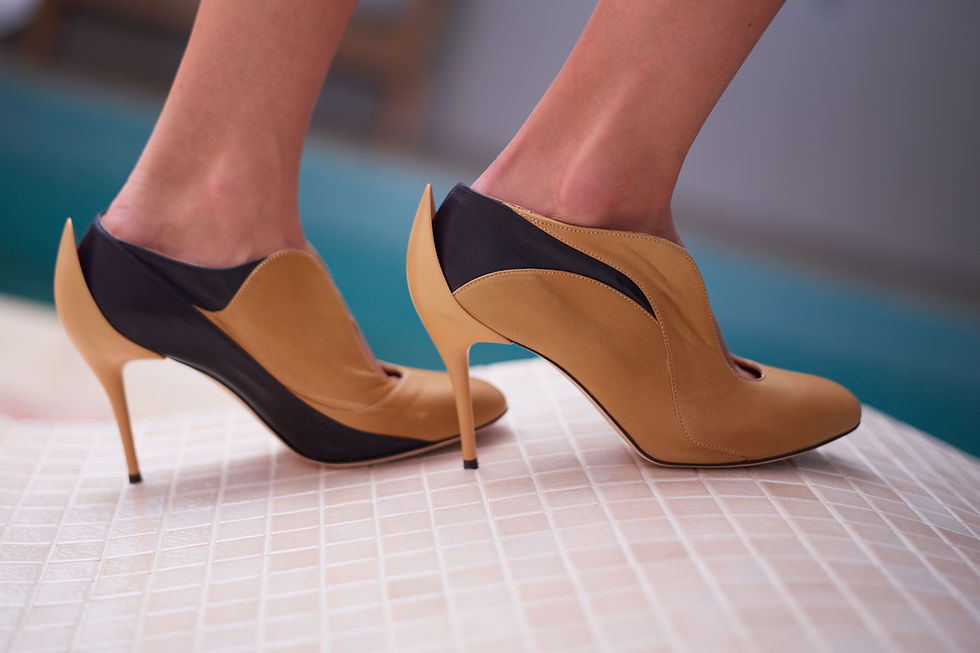Opinion: Stand for what you stand on.
- sales53280
- Apr 23, 2020
- 3 min read
Updated: 6 days ago
Stand for what you stand on. As the founder of Elegnano, that has always been the case for me. What I literally stand on – Elegnano heels – is also what I stand for. But today, I want to highlight that other “thing” I stand on. The “thing” we all stand on: the Earth. While elegance and (nano)technology are at the core of every design that I come up with, comfort and sustainability are very important to me too. Today, because it is Earth Day and the #whomademyclothes campaign is in full throttle, I'd like to shed some light on how Elegnano is working towards sustainability?
Working sustainably starts in the design phase. While I constantly monitor the development of new sustainable materials and I look forward to the commercial availability of a material that could replace leather without losing its unique quality and comfort, currently Elegnano shoes are still made from leather. But we try to minimize the amount of leather we need to use, by minimizing the amount of waste per leather skin. Elegnano designs typically have a lot of small pieces stitched together creating a design with organic flowing lines. This allows us to optimize the surface area of a leather skin and avoid having to throw away good leather.

From the start we’ve paid attention to the sourcing of the materials. Our suppliers not just meet the required European standards but have sustainability in their own DNA. Moreover, we try to source our components as much as possible from the same geographical area to minimize transport between locations. Of course, the circumstances at the factories where the materials are processed and turned into shoes are important too. The factory employees are treated well, work in a safe environment, and are paid a fair price. They are not going to work because they have no other option, but because they are genuinely passionate about and proud of what they do.
After the design and production, comes sales. From the start I’ve made the decision for Elegnano not to be a part of the fast-paced seasonal fashion cycle. Elegnano shoes are classic and timeless. They never go out of style, so why would we push out a new collection with new colors every few months. This slow-fashion model means that we don’t do sales either. And our Summer collection is available when it is actually Summer, and the same for the Winter collection. In contrast to the traditional fashion season cycle where brands launch a Spring/Summer collection in Winter (January/February), and a Fall/Winter collection in Summer (August). The current corona crisis made even Giorgio Armani speak up and acknowledge the absurdness of the current pace and state of the fashion industry (1).
Can we do more? Of course! And I can guarantee you that we will continue to find more ways to be sustainable at Elegnano. My goal is not to make anyone feel bad about eating meat or driving a car. Or even buying a $5 shirt from a fast fashion label. It is much more about thinking twice about it – knowing and understanding what you eat, drink, wear, drive, etc. And where it comes from. Chances are pretty high it will come from somewhere on this planet we stand on… But there is no planet B, so we better take good care of this one.
Katrien Herdewyn
Founder Elegnano

Today (April 22) is the 50th anniversary of Earth Day. A celebration, but also an awakening. We all know who Greta Thunberg is. We all remember the protests from young people demanding political action to stop climate change. But (sadly) that wasn’t the first time the youth stood up for planet Earth. It has been 50 years – 1970 - since 20 million young people took the streets for the first time to fight for greater protection of our planet. For half a decade the Earth Day Network has been trying to mobilize the world population to take action and take a stand. Check out their website to get tips and tricks on how to make every day Earth Day (2). #EarthRise #EarthDay50
The "Who Made My Clothes" movement started in 2013 after the Rana Plaza factory collapsed and made (painfully) clear how unacceptable the working conditions of the people making the clothes for a lot of Western (fast) fashion labels were. The #whomademyclothes campaign has been quickly spreading around the world ever since. The organization encourages everyone to demand information from clothing brands about where their clothes come from and who made them. This year's Fashion Revolution Week is from April 20 to April 26. #buylocal (3)



Comments